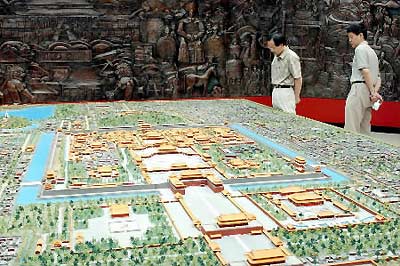The imperial city of Beijing was initially built in early Ming Dynasty. It is the second of the four city walls.

Adjacent to the imperial palace, it connects the exterior and interior cities. Inside the imperial city, there are departments, palaces, temples, warehouses and gardens. The defense and service functions are perfect in the city. The Tian An Men gate tower, Beihai park, Jingshan Hill, Imperial Ancestral Temple (now the Working People's Cultural Palace), Altar to the god of the land and grain (now the Zhongshan Park) and Pudu Temple are all situated inside the imperial city.
When the imperial city of Beijing on the whole applied for the World Cultural Heritages, Beijing imperial city art museum was open on June, 2003. Ahead are the copper sculptures and behind are the armors of the guards. Here hangs the exquisite official costume, and there displays the city brick recording the 300-year-old history of Ming Dynasty. The imperial candles, shades, lanterns, and playbills, and jade inscriptions…treasures as tributes to the emperor and those pigeon whistles and other rare cultural items concerning pigeon culture, will you let them pass without giving a second glimpse?
Further Information:
Address: Inside the Puchanghe Park, Dongcheng District, Beijing
Bus Route: Bus No. 1, 2, 4, 10, 20, 37, 52, 59, 120, 120(branch), 728, 8201(special) to the bus stop of Tian'anmen, Underground Railway to the station of East Tian'anmen.
Opening Hours: 9: 00-16: 30
Admission Fee: RMB 20 Yuan (Adults), 10 Yuan (Students)
Tel: 8610-85115104
(China.org.cn August 25, 2005)

